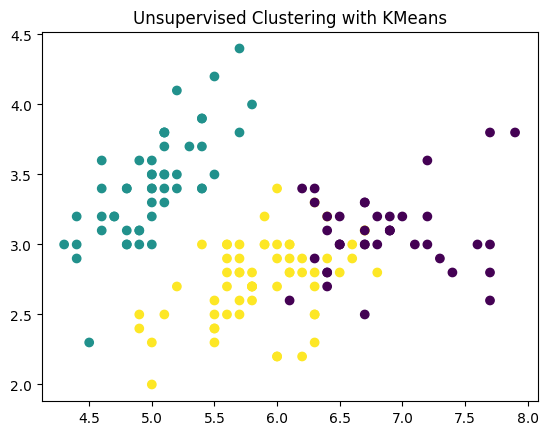📝 🤖 Introduction to Machine Learning: An Engineering Perspective#
🎯 Learning Objectives#
By the end of this lecture, you should be able to:
Understand the fundamental concepts of Machine Learning (ML).
Identify the types of ML: Supervised, Unsupervised, and Reinforcement Learning.
Recognize the importance of data, optimization, and evaluation metrics.
See practical examples using scikit-learn.
🚀 What is Machine Learning?#
Machine Learning is a branch of Artificial Intelligence that enables systems to learn from data and improve performance without explicit programming.
Why is Machine Learning Important in Engineering?#
Predictive Maintenance – Anticipate equipment failures before they happen.
Quality Control – Automatically detect defects in manufacturing.
Optimization – Improve efficiency in logistics and resource management.
Automation – Enable smart systems and autonomous machines.
🔑 Key Concepts in Machine Learning#
Model – An algorithm that learns patterns from data.
Features – Input variables (e.g., temperature, pressure, speed).
Labels – Output variables (e.g., pass/fail, defective/non-defective).
Training – Teaching the model using historical data.
Prediction – Using the model to make decisions on new data.
Example: Predicting Equipment Failure in a Factory#
- Features: Temperature, Vibration, Power Consumption
- Label: Equipment Status (Operational, Maintenance Required, Failed)
- Goal: Predict when maintenance is needed to prevent failures.
🧠 Types of Machine Learning#
1️⃣ Supervised Learning#
- Definition: Models learn from labeled data (input → output).
- Examples: Classification and Regression.
- Use Case: Predicting product quality from sensor data.
from sklearn.model_selection import train_test_split
from sklearn.ensemble import RandomForestClassifier
from sklearn.metrics import accuracy_score
from sklearn.datasets import load_iris
# Load dataset
data = load_iris()
X = data.data # Features
y = data.target # Labels
# Split data into training and testing sets
X_train, X_test, y_train, y_test = train_test_split(
X, y, test_size=0.2, random_state=42
)
# Train a Random Forest Classifier
clf = RandomForestClassifier(n_estimators=100)
clf.fit(X_train, y_train)
# Make predictions and evaluate accuracy
predictions = clf.predict(X_test)
accuracy = accuracy_score(y_test, predictions)
print("Model Accuracy:", accuracy)
Model Accuracy: 1.0
2️⃣ Unsupervised Learning#
Definition: Models find patterns from unlabeled data.
Examples: Clustering, Dimensionality Reduction.
Use Case: Grouping similar products for market segmentation.
from sklearn.cluster import KMeans
import matplotlib.pyplot as plt
# Apply KMeans clustering
kmeans = KMeans(n_clusters=3, random_state=42)
kmeans.fit(X)
labels = kmeans.labels_
# Visualize the clusters
plt.scatter(X[:, 0], X[:, 1], c=labels, cmap="viridis")
plt.title("Unsupervised Clustering with KMeans")
plt.show()

3️⃣ Reinforcement Learning#
Definition: Models learn by interacting with the environment and receiving feedback (rewards or penalties).
Examples: Robotics, Game AI.
Use Case: Autonomous drones for surveying construction sites.
📊 The Importance of Data in ML#
Quality of Data – Clean, accurate, and relevant data is crucial.
Feature Engineering – Selecting and transforming variables to improve model performance.
Training & Testing Split – Divide data into training and testing sets to evaluate performance.
Example: Engineering Dataset#
Dataset: Historical data from a wind turbine (wind speed, blade angle, power output).
Goal: Predict power output based on weather conditions.
🔧 Optimization in Machine Learning#
Optimization is about finding the best model parameters to minimize errors and maximize accuracy.
Cost Function – Measures the difference between predictions and actual values.
Gradient Descent – Algorithm to minimize the cost function.
Hyperparameter Tuning – Adjusting model settings to improve performance.
Example: Tuning a Random Forest Model#
from sklearn.model_selection import GridSearchCV
# Define parameter grid for tuning
param_grid = {"n_estimators": [50, 100, 200], "max_depth": [10, 20, 30]}
# Grid search to find the best parameters
grid_search = GridSearchCV(RandomForestClassifier(), param_grid, cv=3)
grid_search.fit(X_train, y_train)
print("Best Parameters:", grid_search.best_params_)
Best Parameters: {'max_depth': 20, 'n_estimators': 200}
📏 Evaluation Metrics#
Choosing the right metric depends on the problem type:
Accuracy – Percentage of correct predictions (for classification).
Precision & Recall – For imbalanced datasets (e.g., defect detection).
Mean Absolute Error (MAE) – For regression problems.
Confusion Matrix – Shows true positives, false positives, true negatives, and false negatives.
from sklearn.metrics import classification_report, confusion_matrix
# Evaluate the model
print(classification_report(y_test, predictions))
print("Confusion Matrix:\n", confusion_matrix(y_test, predictions))
precision recall f1-score support
0 1.00 1.00 1.00 10
1 1.00 1.00 1.00 9
2 1.00 1.00 1.00 11
accuracy 1.00 30
macro avg 1.00 1.00 1.00 30
weighted avg 1.00 1.00 1.00 30
Confusion Matrix:
[[10 0 0]
[ 0 9 0]
[ 0 0 11]]
🌍 Real-World Applications in Engineering#
Predictive Maintenance – Reducing downtime in manufacturing.
Quality Control – Automated defect detection in production lines.
Energy Optimization – Predicting energy consumption for smart grids.
Structural Health Monitoring – Analyzing sensor data to predict failures in bridges and buildings.
📌 Key Takeaways#
✅ Machine Learning enables systems to learn from data and make predictions.
✅ Supervised, Unsupervised, and Reinforcement Learning are the main types of ML.
✅ Data quality and optimization are critical for accurate models.
✅ Scikit-learn provides powerful tools for implementing ML models.
✅ Engineering applications include predictive maintenance, quality control, and energy optimization.\
🤖 Machine Learning is transforming the future of engineering!

